Marine Life & Conservation Blogs
Why every day should be World Oceans Day…
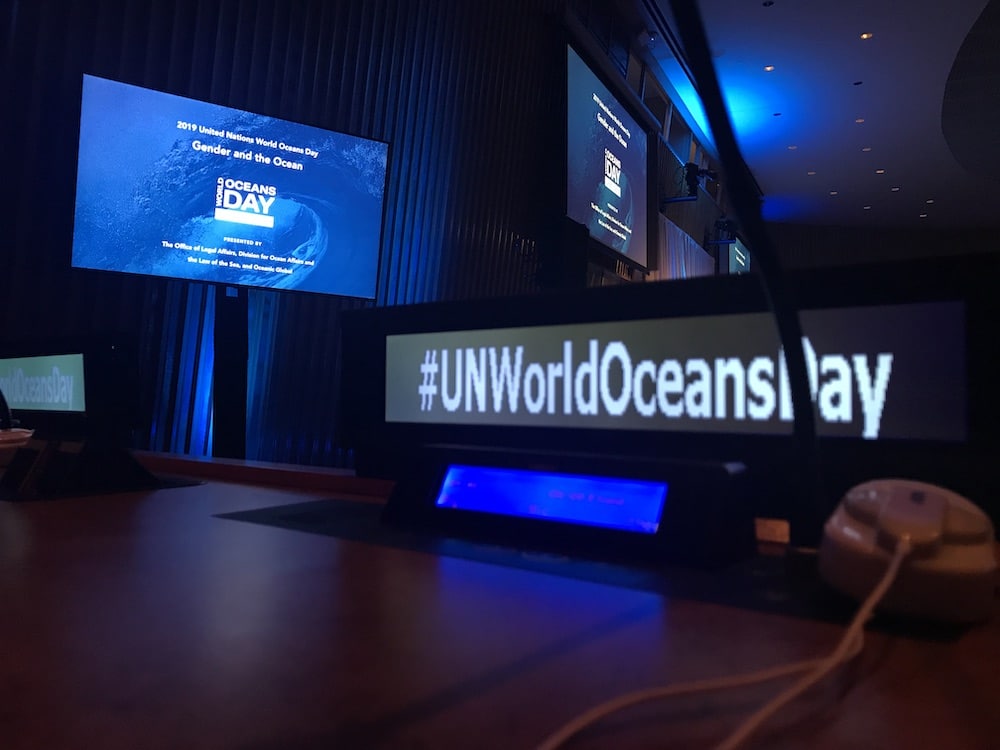
Every day should be World Oceans Day, but until my wish is granted we’re grateful for the one day a year the oceans get global attention.
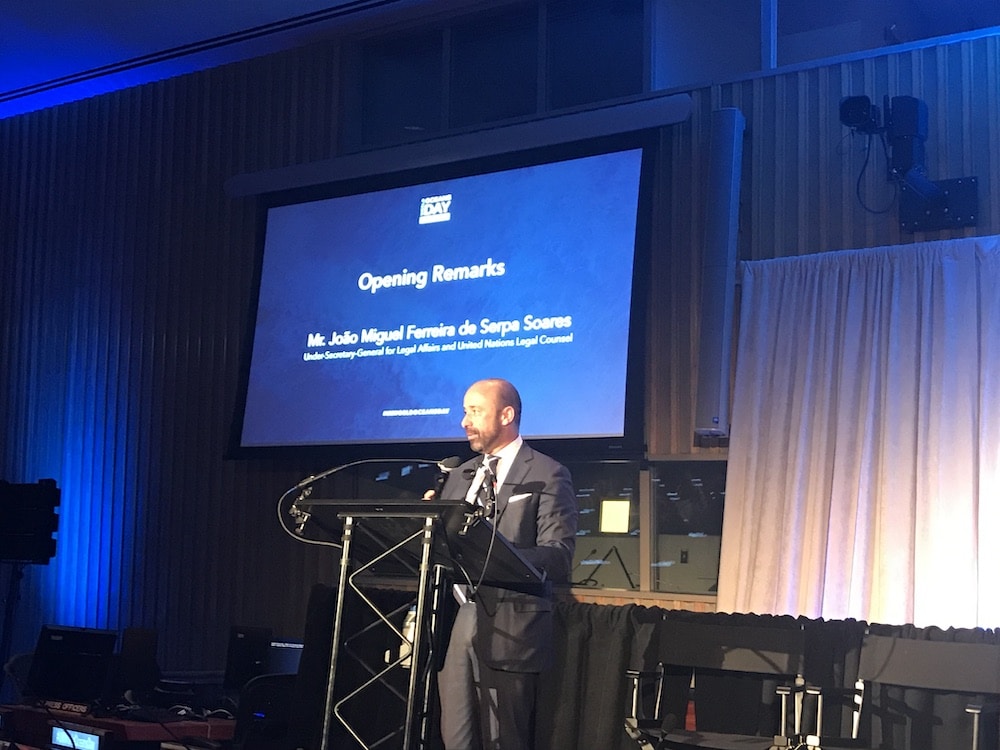
Welcome to UN WOD 2019!
In 2008 the United Nations officially recognized World Oceans Day to be celebrated on the 8th June every year. Since that was a Saturday in 2019, the celebratory event at the United Nations Headquarters in New York took place on Friday 7th themed: Gender and Oceans.
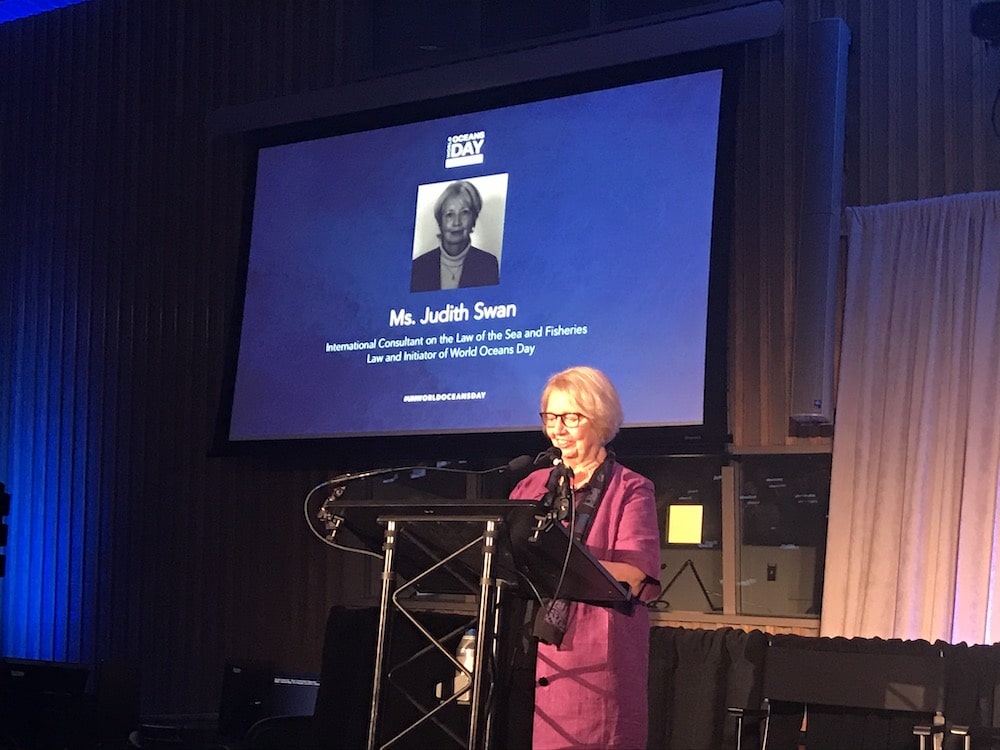
Judith Swan, International Consultant on the Law of the Sea and Fisheries Law, and Initiator, World Oceans Day.
This year the strategic partner Oceanic Global organized a morning of storytelling by men and women and an afternoon panel discussion regarding solutions for gender issues with panellists from the Human Rights at Sea, UN Division of Ocean Affairs and Law of the Sea, the World Surf League and many others.

Kudzi Victorino Dykman at the start of UN WOD 2019 at the NY Headquarters.
Some highlights of the day were the testimony of Kudzi Victorino Dyckman. She was born in Mozambique as the oldest of 14 children and worked as a young child to help provide for her family. Her strong willpower and gratefulness eventually led to her becoming the first female Dive Instructor in Mozambique!
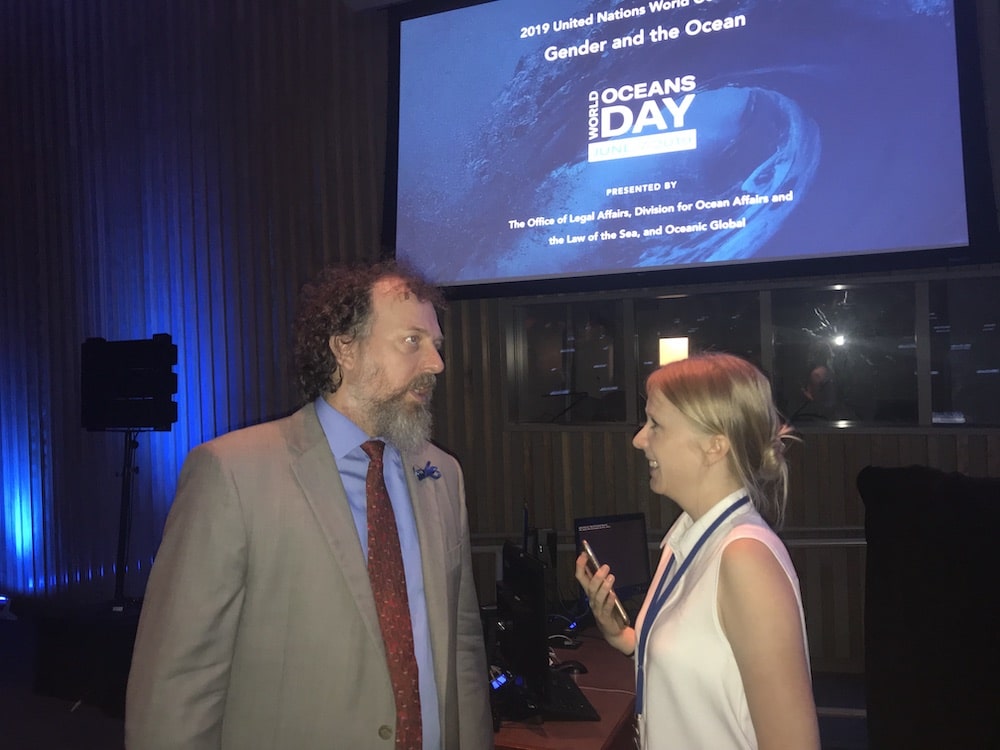
François Bailet from the Office of Legal Affairs – Division of Ocean Affairs and the Law of the Sea – is the driving force behind the UN WOD. Here, in discussion with Amanda Elise Stoltz.
And what about the real life Moana: Aunofo Havea – a true seafarer following the stars and her dream, from cleaning to cooking to captain because she wanted to be the decision maker, while raising a family! Some people in the dive industry might know her as an inspirational power woman operating in Tonga – her dream since she first swam with the whales.
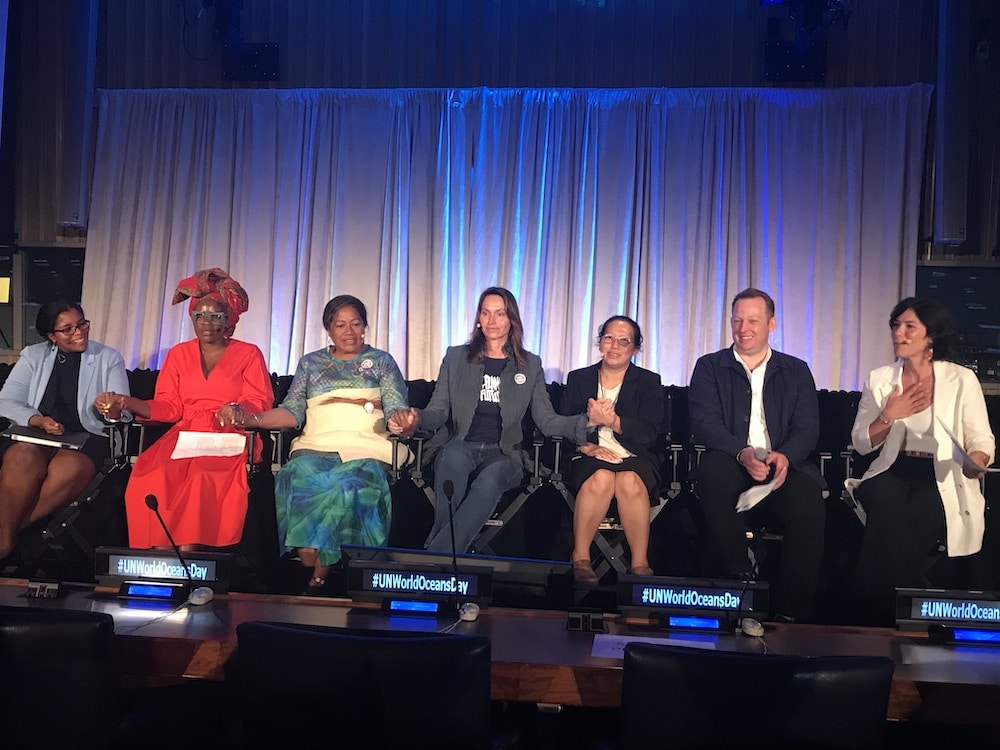
Storytelling panel: Ms. Angelique Pouponneau, Kudzi Victorino Dykman, Aunofo Havea, Anne de Carbuccio, Patima Tungpuchayaku, and moderator Mariasole Bianco.
We also heard goosebump testimonies from a former slave at sea and now the founder of Labour Rights Promotion Network Foundation, Mr. Tun Lin.
In between the stories and panels, I had the honour to announce the winners of the 6th UN World Oceans Day Photo Competition. The overall winner, David Salvatori from Italy, presented a stunning shot of a diver between floating tunicates! A symbol that we need the motion in the ocean to keep them rich and full with life. Check back here tomorrow to see the images!
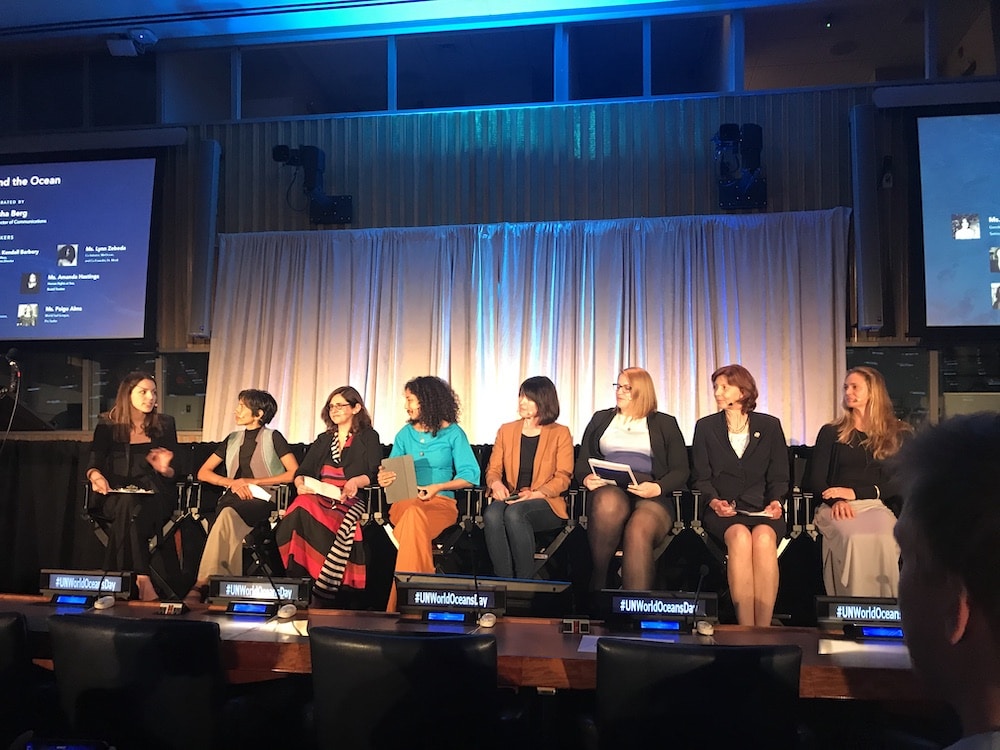
Expert panel with moderator Natasha Berg, Anamika Amani, Francesca Santoro, Lynn Zebeda, Kendall Barbery, Amanda Hastings, Gabriele Goettsche-Wanli and Paige Alms.
The day ended with a compelling speech by Dr. Sylvia Earle about the knowledge we have and the choices we make, or rather not make fast enough. We have to make peace with nature and that is not a gender issue but a cultural one. But women with superpowers all around the world can make a difference as we should provide the values at home so they become second nature.
We can do this partly by embracing the differences there are between men and women and using the differences in decision making like ones we all make at home: what shall we eat? We have to stop eating marine life because we’re all guilty in playing a part in the atrocities happening at sea if we don’t. In our food choices, we are implicated in everything from overfishing to forced labour at sea.
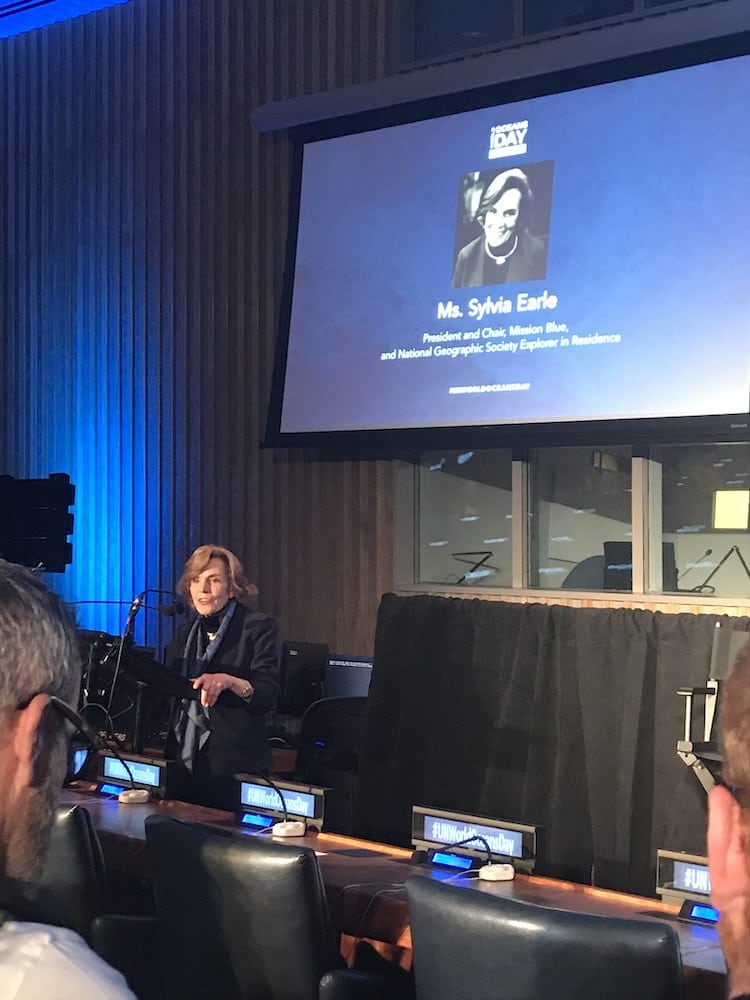
Dr. Sylvia Earle delivering the closing keynote speech and moving everyone to tears.
When a scientist with the experience and hours in the ocean like Dr. Earle tells you what to do… you better listen!
Conclusion: Gender and the Oceans seemed like a difficult theme when it got announced months ago, but the day was too short once the dialogue began! To be continued…
Find out more about Ellen and her work at www.ellencuylaerts.com.
Marine Life & Conservation Blogs
Book Review: Shells of the World

Shells of the World: A Natural History by M.G. Harasewych
Shells of the world is a guide to the world of marine, shelled molluscs. And what a varied and interesting world it is. Some of my favourite things to find on a dive are detailed in this book, including disco clams (or Electric File Clams as they are correctly names), the cephalopods, giant clams and sea hares. There are also many on my wish list, top of which is the Nautilus.
Each chapter provides a detailed description of the species, along with beautiful images. You can dive deeper and discover where they live, both with global distribution and the habitat they prefer. Learn about their diet, reproduction and diversity.
Having dipped in and out of this lovely book over the past few weeks, it has inspired me to learn more about this group of animals that we see on most divers, wherever we are in the world. Some of the shells are incredibly intricate and beautiful. I have always agreed with never collecting, or touching, marine life. The description of a certain set of cone shells should be a warning to those that are happy to pick up marine life! One of the cone shells has a local name called the cigarette snail. Why? Because once the venom is in your system from this animal, you only have time to smoke one cigarette before the affects of the venom are fatal!
What the publisher says:
Mollusks are invertebrate animals with a remarkable natural history and a rich fossil record, and their shells are prized for their breathtaking variety and exquisite beauty. Shells of the World provides a wide-ranging look at the incredible diversity of marine mollusks. An informative introduction outlines the lineages covered, followed by a directory section, split into classes, that profiles a broad selection of different taxa to give a sense of their sheer numbers and variety.
- Features hundreds of beautiful color photos, depicting both the live animals and their shells
- Discusses mollusk evolution, anatomy, life cycles, behavior, and ecology
- Describes unique characteristics, distribution, habitat, and size
- Provides valuable insights into the conservation of the world’s marine mollusks
- Ideal for malacologists and shell collectors everywhere
About the Author:
M. G. Harasewych is research zoologist emeritus and former curator in the Department of Invertebrate Zoology at the Smithsonian Institution’s National Museum of Natural History. A fellow of the American Association for the Advancement of Science, he is the author (with Fabio Moretzsohn) of The Book of Shells: A Life-Size Guide to Identifying and Classifying Six Hundred Seashells.
Book Details
Publisher: Princeton University Press
Hardcover
Price: £25
ISBN: 9780691248271
Published: 9th April, 2024
Blogs
The Ocean Cleanup Breaks 10,000,000 KG Barrier

The Ocean Cleanup, the global non-profit project, has removed a verified all-time total of ten million kilograms (22 million lbs.) of trash from oceans and rivers around the world – approximately the same weight as the Eiffel Tower.
To complete its mission of ridding the oceans of plastic, The Ocean Cleanup uses a dual strategy: cleaning up the Great Pacific Garbage Patch (GPGP) to remove the plastic already afloat in the oceans, while stopping the flow of plastic from the world’s most polluting rivers.
Through cleaning operations in the GPGP and in rivers in eight countries, the cumulative total of trash removed has now surpassed ten million kilograms. This milestone demonstrates the acceleration of The Ocean Cleanup’s impact, while underlining the astonishing scale of the plastic pollution problem and the need for continued support and action.
While encouraging for the mission, this milestone is only a staging point: millions more tons of plastic still pollute our oceans and The Ocean Cleanup intends to continue learning, improving and innovating to solve this global catastrophe.
This announcement comes as governments from around the world meet to continue negotiations to develop a new legally binding instrument to end plastic pollution at INC4 in Ottawa, Canada. Representatives of The Ocean Cleanup will be in attendance and the organization will be urging decision-makers to collaborate towards a comprehensive and ambitious global treaty which addresses plastic at all stages of its life cycle and in all marine environments worldwide, including in areas beyond national jurisdiction.
It is encouraging to see that the need for remediation is reflected in the various options for potential treaty provisions. It is essential that the final treaty contains clear targets for the remediation of legacy plastic pollution, and reduction of riverine plastic emissions.
Tackling plastic pollution requires innovative and impactful solutions. The treaty should therefore incentivize the innovation ecosystem by fostering innovations that make maximal use of data, technology and scientific knowledge – such as those designed and deployed by The Ocean Cleanup.
‘After many tough years of trial and error, it’s amazing to see our work is starting to pay off – and I am proud of the team who has brought us to this point.’ said Boyan Slat, Founder and CEO of The Ocean Cleanup. ‘While we still have a long way to go, our recent successes fill us with renewed confidence that the oceans can be cleaned.’
The Ocean Cleanup was founded in 2013 and captured its first plastic in 2019, with the first confirmed catch in the GPGP coming soon after the deployment of Interceptor 001 in Jakarta, Indonesia. After surpassing one million kilograms of trash removed in early 2022, the non-profit project has since progressed to the third iteration of its GPGP cleaning solution, known as System 03, and a network of Interceptors currently covering rivers in eight countries, with more deployments set for 2024.
About The Ocean Cleanup
The Ocean Cleanup is an international non-profit organization that develops and scales technologies to rid the world’s oceans of plastic. They aim to achieve this goal through a dual strategy: stemming the inflow via rivers and cleaning up the legacy plastic that has already accumulated in the ocean. For the latter, The Ocean Cleanup develops large-scale systems to efficiently concentrate the plastic for periodic removal. This plastic is tracked and traced through DNV’s chain of custody model to certify claims of origin when recycling it into new products. To curb the tide via rivers, The Ocean Cleanup has developed Interceptor™ solutions to halt and extract riverine plastic before it reaches the ocean. Founded in 2013 by Boyan Slat, The Ocean Cleanup now employs a broadly multi-disciplined team of approximately 140. The foundation is headquartered in Rotterdam, the Netherlands.
For more information, visit: theoceancleanup.com and follow @theoceancleanup on social media.
-

 News3 months ago
News3 months agoCapturing Critters in Lembeh Underwater Photography Workshop 2024: Event Roundup
-

 Marine Life & Conservation Blogs3 months ago
Marine Life & Conservation Blogs3 months agoCreature Feature: Swell Sharks
-

 Gear Reviews4 weeks ago
Gear Reviews4 weeks agoGEAR REVIEW – Revolutionising Diving Comfort: The Sharkskin T2 Chillproof Suit
-

 Blogs2 months ago
Blogs2 months agoMurex Resorts: Passport to Paradise!
-

 Blogs3 months ago
Blogs3 months agoDiver Discovering Whale Skeletons Beneath Ice Judged World’s Best Underwater Photograph
-

 News3 months ago
News3 months agoPADI Teams Up with Wellness Brand Neuro to Drive Ocean Change and Create a Blue State of Mind
-

 Gear Reviews3 months ago
Gear Reviews3 months agoGear Review: Oceanic+ Dive Housing for iPhone
-

 Marine Life & Conservation2 months ago
Marine Life & Conservation2 months agoSave the Manatee Club launches brand new webcams at Silver Springs State Park, Florida


















